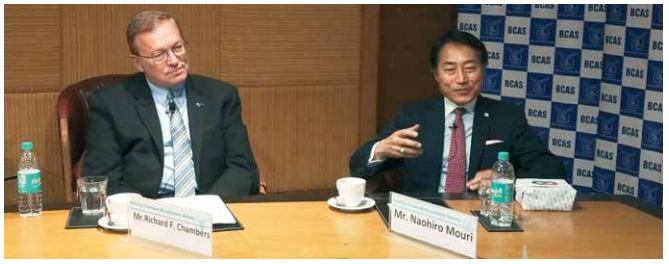(a) Section 32(1)(iii) of the Income-tax Act, 1961 — Unit acquired at slump price — Amount allocated towards trademark, brand name, logo, etc. and technical know-how by approved valuer is capital expenditure eligible for depreciation claim.
(b) Section 92C of the Income-tax Act, 1961 read with Rules 10B(1)(a), 10B(1)(c) and 10B(1)(e) of the Income-tax Rules, 1962 — Transfer pricing — Most appropriate method for computing arm’s-length price — Rates charged to the third parties in the domestic market cannot be compared with the rates charged to AE in the export market — There are various factors which affect the pricing of the product in the domestic market vis-à-vis the export market — Hence the CPM method is not appropriate method for determining the ALP — CUP or TNMM was the most appropriate method for determining ALP.
Facts:
(a) Depreciation u/s.32(1)(iii)
The assessee acquired the unit of G on slump-sales basis consisting of all its assets which included intellectual property rights such as designs, drawings, manufacturing processes and technical know-how for a consideration of Rs.17.01 crore. The registered valuer valued the knowhow acquired at Rs.2.41 crore and royalty payable for use of brand name, trademark, logo, etc. at Rs.2.67 crore. The Assessing Officer disallowed depreciation on the same on the basis that as per agreement, the assessee has not purchased any know-how from G and the assessee is entitled to use trademark, logo and brand name of G free of cost for a period of three years.
Held:
The Tribunal, relying on the decisions in the following cases, allowed the assessee’s claim:
(a) Amway India Enterprises v. Dy. CIT, (2008) 114 TTJ 476 (Del.) (SB)/(2008) 4 DTR (Del.) (SB) (Trib.) 1/(2008) 111 ITD 112 (Del.) (SB)
(b) Hindustan Coca Cola Beverages (P.) Ltd. v. Dy. CIT, (2010) 43 DTR (Del.) 416
The Tribunal noted as under:
(1) It is an undisputed fact that the assessee has paid the agreed consideration of Rs. 17.01 crore as a lump-sum amount to purchase the unit in its entirety i.e., the unit consisting of items like trademark, logo and brand name, designs, drawings, manufacturing processes and technical know-how.
(2) Simply because, in the agreement to purchase, it is mentioned that the use of all items like trademark, logo and brand name is allowed to the assessee for three years by G free of cost, it does not mean that there is no value for these items. The agreement between the seller and the purchaser does not put restriction on the right of the purchaser to record the asset at its fair value in its books.
(3) The apportionment of the lump-sum amount amongst the various assets and rights has to be made and which has been done in the present case as per the valuer’s report. The approved valuer has valued the know-how acquired at Rs.2.41 crore and royalty payable for use of brand name, trademark and logo at Rs.2.67 crore.
(4) The Special Bench of the Tribunal in the case of Amway India (supra) has held that if the software is useable/used for more than two years, it is a capital expenditure and if it is for less than two years, it is revenue expenditure. Thus, following the ratio laid down therein, since the assessee had purchased the use of brand name, trademark, logo for three years and similarly, the intellectual property right such as design, drawings, manufacturing processes and technical know-how in respect of the products manufactured by the unit was acquired, the expenditure incurred in this regard as valued by the approved valuer is capital expenditure on which the claim of depreciation was allowable.
Facts:
(b) Computation of ALP
During the year, the assessee-company sold goods to its associate enterprises (AEs). Initially, while filing the return of income, the assessee had adopted the comparable uncontrolled price method (CUP) for determining the arm’s-length price (ALP) in respect of exports transactions undertaken with the AE. Thereafter, in the proceedings before the learned TPO, the assessee contended that even as per transactional net margin method (TNMM), the transactions of export of goods are at ALP. The revised Form No. 3CEB was filed and details of the company selected as comparable were furnished. The learned TPO did not agree with the submissions of the assessee and held that the CUP method and TNMM are not applicable for determining the ALP. The learned TPO has considered the gross margin earned by the assessee in the export segment visà- vis gross margin earned in the domestic segment. Accordingly, he has held that the gross margin in the domestic segment is much higher than the margin earned in the export segment and, hence, he made an addition of Rs.58.54 lakh.
Held:
The Tribunal held that the TPO was not justified in adopting CPM and in comparing the gross margin in export segment vis-à-vis gross margin in domestic segment of the assessee without appreciating that the CUP or TNMM was the most proper method for determining the ALP. The TPO was directed to accept the claim of the assessee regarding the ALP based on TNMM which method has been accepted in the succeeding year.
The Tribunal noted as under:
(1) Rates charged to the third parties in the domestic market cannot be compared with the rates charged to AE in the export market. There are various factors which affect the pricing of the product in the domestic market vis-à-vis the export market and, therefore, the price cannot be compared. The assessee has to bear substantial marketing cost in the domestic segment, there is no bad debt risk in respect of the sales made to the AE and no product liability risk. Besides, it is also a material aspect that the assessee has to bear product liability risks like retention money, bank guarantee, warranty, etc. in the domestic segment, but such risks are not to be borne in the export segment. Due to these factors, the assessee has to charge higher rates in the domestic segment and, therefore, comparison of the rates of the products in the domestic segment and the export segment is not justified.
(2) For the A.Y. 2007-08, the assessee has adopted TNMM for determining the ALP and the TPO has accepted the same. There is substance in the alternative submissions of the authorised representative that TNMM can also be accepted during the year for determining the ALP.









